lombok作用
在平常写代码的时候,我们写javabean的时候都要写get,set方法,虽然可以自动生成,但是看上去还是不太好看,还有就是在打印日志的时候,我们先要获取到log对象,每个类都要写一遍非常的麻烦,lombok就可以帮我们解决这些问题。
Lombok能以简单的注解形式来简化java代码,提高开发人员的开发效率。Lombok能通过注解的方式,在编译时自动为属性生成构造器、getter/setter、equals、hashcode、toString方法。出现的神奇就是在源码中没有getter和setter方法,但是在编译生成的字节码文件中有getter和setter方法。这样就省去了手动重建这些代码的麻烦,使代码看起来更简洁些。
使用lombok前:
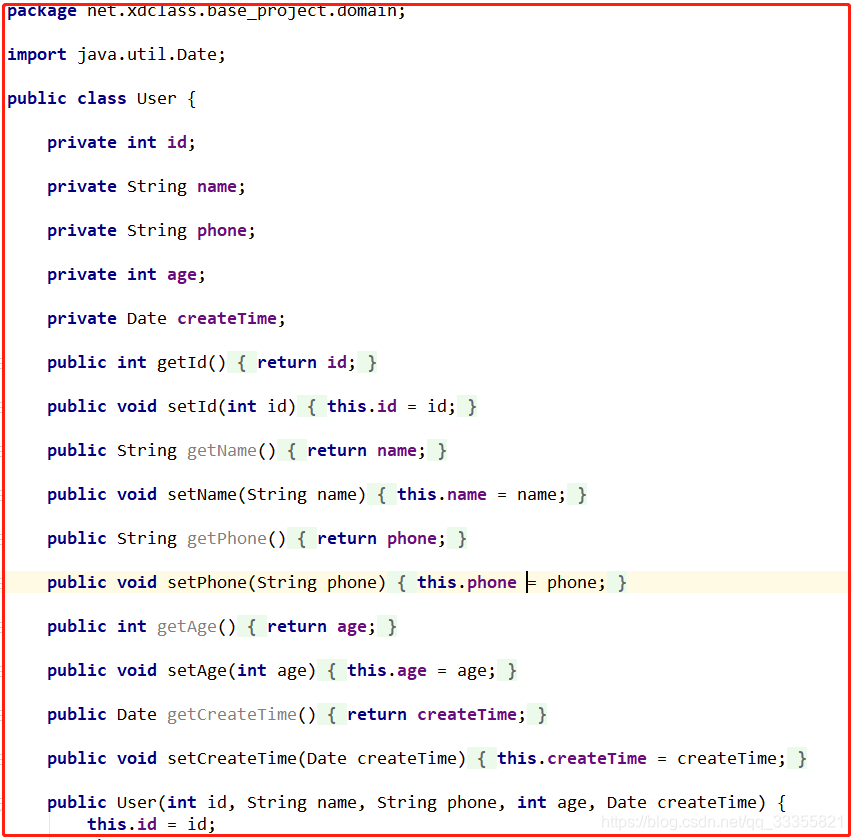
使用lombok后:
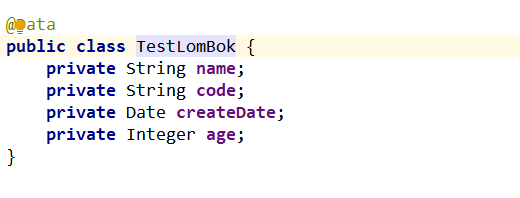
使用lombok前:
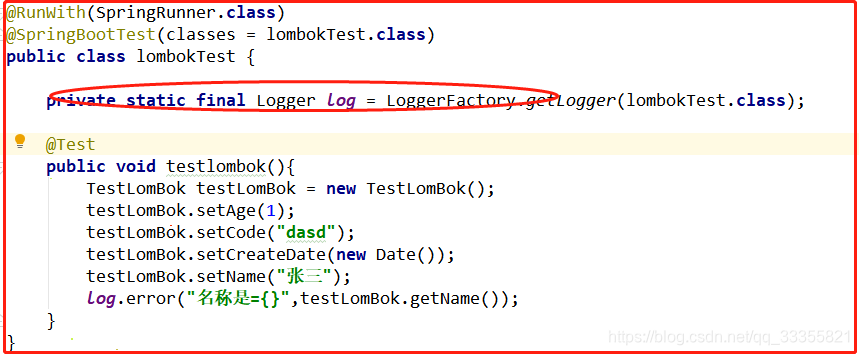
使用lombok后:
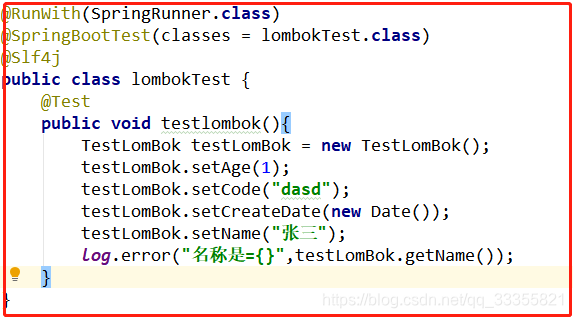
IDEA使用lombok
1.先在idea的插件中下载lombok插件,然后重启idea
2.勾上Enable annotation processing
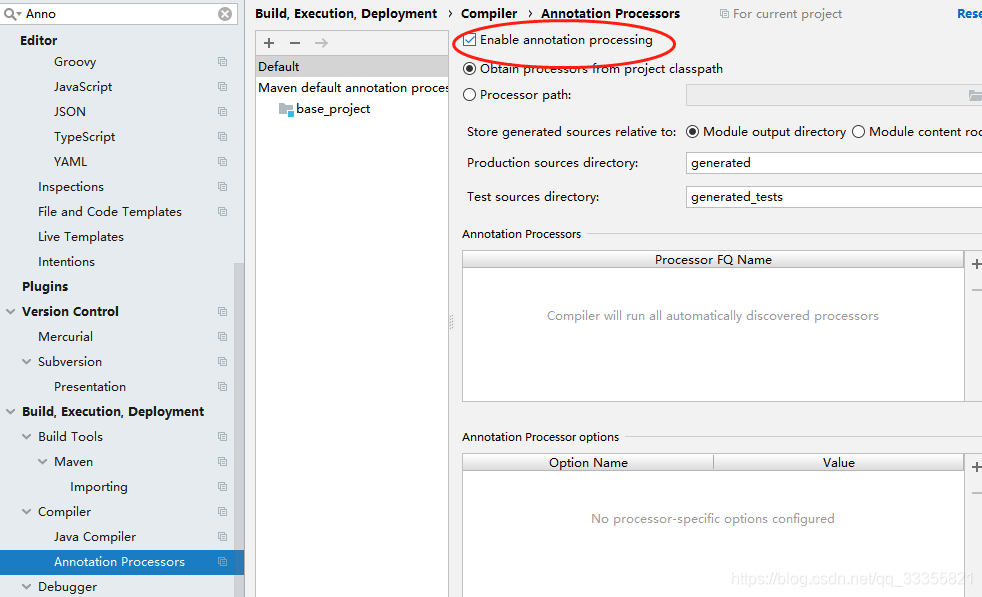
3.在pom文件中加入以下依赖 ,然后就可以使用lombok了
<!--lombok-->
<dependency>
<groupId>org.projectlombok</groupId>
<artifactId>lombok</artifactId>
</dependency>具体使用
@Data(常用)
@Data直接修饰POJO or beans, getter所有的变量,setter所有不为final的变量。如果你不需要默认的生成方式,直接填写你需要的annotation的就可以了。默认生成的所有的annotation都是public的,如果需要不同权限修饰符可以使用AccessLevel.NONE选项。当然@Data 也可以使用staticConstructor选项生成一个静态方法。
=@Setter+@Getter+@EqualsAndHashCode+@NoArgsConstructor
//原始类
@Data
public class TestEntity {
@Setter(AccessLevel.PRIVATE)
private String name;
private Integer age;
private final String type = "person";
}
//反编译的类
public class TestEntity {
private String name;
private Integer age;
private final String type = "person";
public TestEntity() {
}
public String getName() {
return this.name;
}
public Integer getAge() {
return this.age;
}
public String getType() {
this.getClass();
return "person";
}
public void setAge(Integer age) {
this.age = age;
}
public boolean equals(Object o) {
if(o == this) {
return true;
} else if(!(o instanceof TestEntity)) {
return false;
} else {
TestEntity other = (TestEntity)o;
if(!other.canEqual(this)) {
return false;
} else {
label47: {
String this$name = this.getName();
String other$name = other.getName();
if(this$name == null) {
if(other$name == null) {
break label47;
}
} else if(this$name.equals(other$name)) {
break label47;
}
return false;
}
Integer this$age = this.getAge();
Integer other$age = other.getAge();
if(this$age == null) {
if(other$age != null) {
return false;
}
} else if(!this$age.equals(other$age)) {
return false;
}
String this$type = this.getType();
String other$type = other.getType();
if(this$type == null) {
if(other$type != null) {
return false;
}
} else if(!this$type.equals(other$type)) {
return false;
}
return true;
}
}
}
protected boolean canEqual(Object other) {
return other instanceof TestEntity;
}
public int hashCode() {
boolean PRIME = true;
byte result = 1;
String $name = this.getName();
int result1 = result * 59 + ($name == null?43:$name.hashCode());
Integer $age = this.getAge();
result1 = result1 * 59 + ($age == null?43:$age.hashCode());
String $type = this.getType();
result1 = result1 * 59 + ($type == null?43:$type.hashCode());
return result1;
}
public String toString() {
return "TestEntity(name=" + this.getName() + ", age=" + this.getAge() + ", type=" + this.getType() + ")";
}
private void setName(String name) {
this.name = name;
}
}
@Setter
生成setter方法,final变量不包含
//原始类
@Setter
public class TestEntity {
private String name;
private Integer age;
private final String type = "type";
}
//反编译的类
public class TestEntity {
private String name;
private Integer age;
private final String type = "person";
public TestEntity() {
}
public void setName(String name) {
this.name = name;
}
public void setAge(Integer age) {
this.age = age;
}
}
@Getter
生成getter方法,final变量不包含
//原始类
@Getter
public class TestEntity {
private String name;
private Integer age;
private final String type = "person";
}
//反编译的类
public class TestEntity {
private String name;
private Integer age;
private final String type = "person";
public TestEntity() {
}
public String getName() {
return this.name;
}
public Integer getAge() {
return this.age;
}
public String getType() {
this.getClass();
return "person";
}
}@NoArgsConstructor
生成空参构造
//原始类
@NoArgsConstructor
public class TestEntity {
private String name;
private Integer age;
private final String type = "person";
}
//反编译的类
public class TestEntity {
private String name;
private Integer age;
private final String type = "person";
public TestEntity() {
}
}@AllArgsConstructor
生成全部参数构造
//原始类
@AllArgsConstructor
public class TestEntity {
private String name;
private Integer age;
private final String type = "person";
}
//反编译的类
public class TestEntity {
private String name;
private Integer age;
private final String type = "person";
@ConstructorProperties({"name", "age"})
public TestEntity(String name, Integer age) {
this.name = name;
this.age = age;
}
}@RequiredArgsConstructor
将标记为@NoNull的属性生成一个构造器
//原始类
@RequiredArgsConstructor
public class TestEntity {
private String name;
@NonNull
private Integer age;
private final String type = "person";
}
//反编译的类
public class TestEntity {
private String name;
@NonNull
private Integer age;
private final String type = "person";
@ConstructorProperties({"age"})
public TestEntity(@NonNull Integer age) {
if(age == null) {
throw new NullPointerException("age");
} else {
this.age = age;
}
}
}@Builder
构造Builder模式的结构。通过内部类Builder()进行构建对象。
//原始类
@Builder
public class TestEntity {
private String name;
private Integer age;
private final String type = "person";
}
//反编译的类
public class TestEntity {
private String name;
private Integer age;
private final String type = "person";
@ConstructorProperties({"name", "age"})
TestEntity(String name, Integer age) {
this.name = name;
this.age = age;
}
public static TestEntity.TestEntityBuilder builder() {
return new TestEntity.TestEntityBuilder();
}
public static class TestEntityBuilder {
private String name;
private Integer age;
TestEntityBuilder() {
}
public TestEntity.TestEntityBuilder name(String name) {
this.name = name;
return this;
}
public TestEntity.TestEntityBuilder age(Integer age) {
this.age = age;
return this;
}
public TestEntity build() {
return new TestEntity(this.name, this.age);
}
public String toString() {
return "TestEntity.TestEntityBuilder(name=" + this.name + ", age=" + this.age + ")";
}
}
}
//Builder模式使用方法
@Test
public void test(){
TestEntity testEntity = TestEntity.builder()
.name("java")
.age(18)
.build();
}@Value
与@Data相对应的@Value, 两个annotation的主要区别就是如果变量不加@NonFinal ,@Value会给所有的弄成final的。当然如果是final的话,就没有set方法了。
//原始类
@Value
public class TestEntity {
@Setter(AccessLevel.PRIVATE)
private String name;
private Integer age;
private final String type = "person";
}
//反编译的类
public final class TestEntity {
private final String name;
private final Integer age;
private final String type = "person";
@ConstructorProperties({"name", "age"})
public TestEntity(String name, Integer age) {
this.name = name;
this.age = age;
}
public String getName() {
return this.name;
}
public Integer getAge() {
return this.age;
}
public String getType() {
this.getClass();
return "person";
}
public boolean equals(Object o) {
if(o == this) {
return true;
} else if(!(o instanceof TestEntity)) {
return false;
} else {
TestEntity other;
label44: {
other = (TestEntity)o;
String this$name = this.getName();
String other$name = other.getName();
if(this$name == null) {
if(other$name == null) {
break label44;
}
} else if(this$name.equals(other$name)) {
break label44;
}
return false;
}
Integer this$age = this.getAge();
Integer other$age = other.getAge();
if(this$age == null) {
if(other$age != null) {
return false;
}
} else if(!this$age.equals(other$age)) {
return false;
}
String this$type = this.getType();
String other$type = other.getType();
if(this$type == null) {
if(other$type != null) {
return false;
}
} else if(!this$type.equals(other$type)) {
return false;
}
return true;
}
}
public int hashCode() {
boolean PRIME = true;
byte result = 1;
String $name = this.getName();
int result1 = result * 59 + ($name == null?43:$name.hashCode());
Integer $age = this.getAge();
result1 = result1 * 59 + ($age == null?43:$age.hashCode());
String $type = this.getType();
result1 = result1 * 59 + ($type == null?43:$type.hashCode());
return result1;
}
public String toString() {
return "TestEntity(name=" + this.getName() + ", age=" + this.getAge() + ", type=" + this.getType() + ")";
}
}@Synchronized
同步方法
//原始类
public class TestEntity {
private String name;
private Integer age;
private final String type = "person";
@Synchronized
public void write(){
//do something
}
}
//反编译的类
public class TestEntity {
private final Object $lock = new Object[0];
private String name;
private Integer age;
private final String type = "person";
public TestEntity() {
}
public void write() {
Object var1 = this.$lock;
synchronized(this.$lock) {
;
}
}
}@Cleanup @@SneakyThrows
自动调用close方法关闭资源。
//原始类
public class TestEntity {
private String name;
private Integer age;
private final String type = "person";
@SneakyThrows
public void outputStream(){
@Cleanup OutputStream outputStream = new FileOutputStream(new File("/Users/hello"));
}
}
//反编译的类
public class TestEntity {
private String name;
private Integer age;
private final String type = "person";
public TestEntity() {
}
public void outputStream() {
try {
FileOutputStream $ex = new FileOutputStream(new File("/Users/hello"));
if(Collections.singletonList($ex).get(0) != null) {
$ex.close();
}
} catch (Throwable var2) {
throw var2;
}
}
}@log
自动获取log实例,有如下的注解方式,在SpringBoot中我就是使用的@Slf4j注解
//@CommonsLog
private static final org.apache.commons.logging.Log log = org.apache.commons.logging.LogFactory.getLog(LogExample.class);
//@JBossLog
private static final org.jboss.logging.Logger log = org.jboss.logging.Logger.getLogger(LogExample.class);
//@Log
private static final java.util.logging.Logger log = java.util.logging.Logger.getLogger(LogExample.class.getName());
//@Log4j
private static final org.apache.log4j.Logger log = org.apache.log4j.Logger.getLogger(LogExample.class);
//@Log4j2
private static final org.apache.logging.log4j.Logger log = org.apache.logging.log4j.LogManager.getLogger(LogExample.class);
//@Slf4j
private static final org.slf4j.Logger log = org.slf4j.LoggerFactory.getLogger(LogExample.class);
//@XSlf4j
private static final org.slf4j.ext.XLogger log = org.slf4j.ext.XLoggerFactory.getXLogger(LogExample.class);参考https://blog.youkuaiyun.com/u013225178/article/details/80721799








 Lombok是一款能够显著减少Java代码冗余的工具,它通过注解在编译阶段自动生成getter、setter等方法,使得代码更加简洁。本文详细介绍了Lombok的安装配置及常用注解的使用方法。
Lombok是一款能够显著减少Java代码冗余的工具,它通过注解在编译阶段自动生成getter、setter等方法,使得代码更加简洁。本文详细介绍了Lombok的安装配置及常用注解的使用方法。
















 1326
1326

 被折叠的 条评论
为什么被折叠?
被折叠的 条评论
为什么被折叠?








